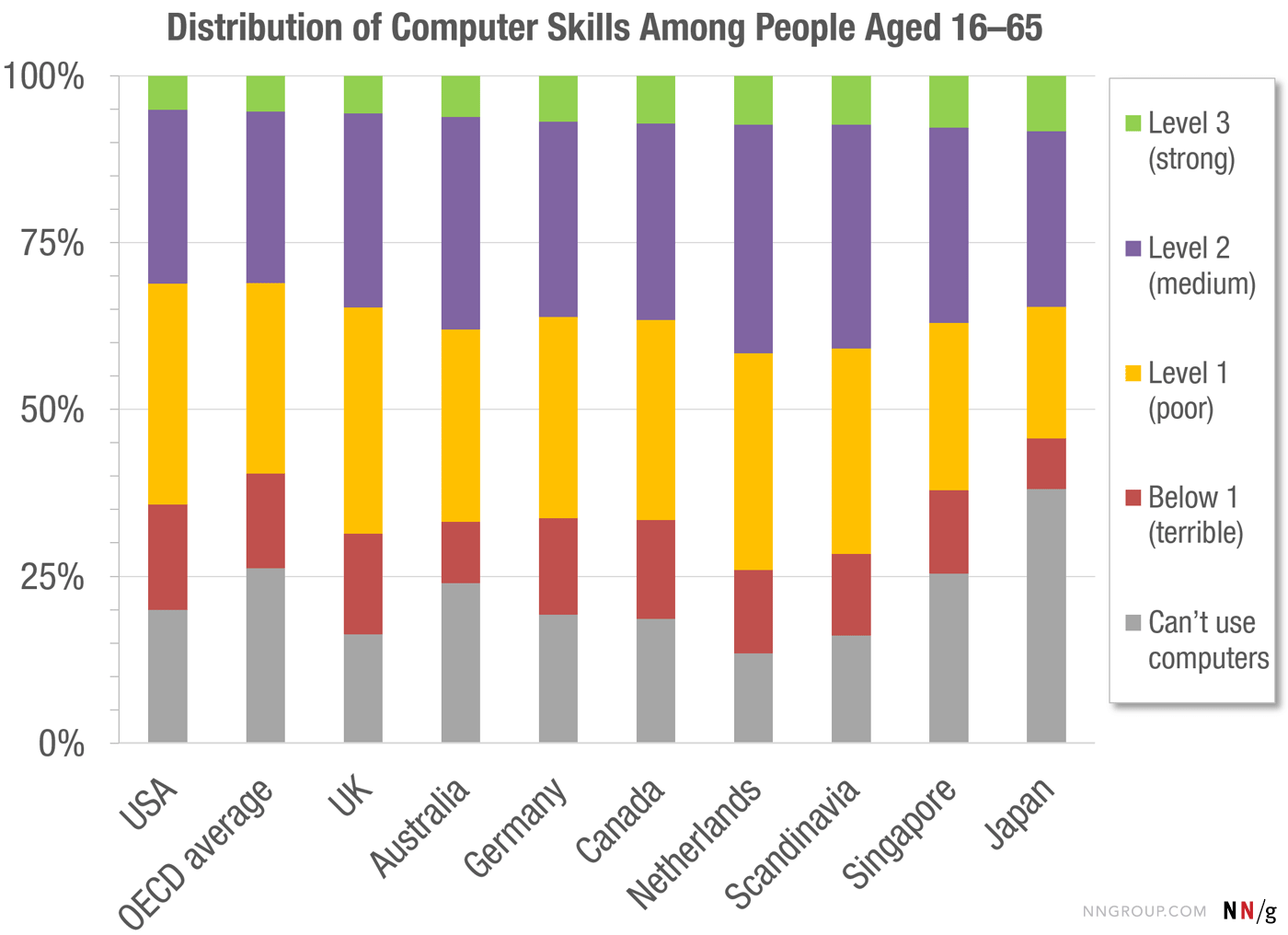Understanding more about how website design can improve your online engagement and conversion numbers can make a difference your bottom line in the coming year.

Some interesting — and some worrisome — new research provides insight into how our prospects and clients use computer technology and the internet to find what they’re looking for.
A recent multinational study revealed some surprising facts about computer literacy in today’s technology-dependent world.

The study determined that 26 percent of adults do not know how to use a computer. In the United States, 35 percent of the population either cannot use a computer, or they have skills that qualify as very poor. Another 35 percent of U.S. residents were determined to have poor computer skills. Only 5 percent of Americans demonstrated strong computer abilities.
These statistics are explained, at least somewhat, by similar studies that rank the United States far below other developed nations for problem-solving skills in a technology-rich environment, as well as in overall literacy.
This research illustrates the importance of website design for low-literacy users. The problem is that web designers — and the majority of business owners — fall into the relatively small category of Americans who have strong computer and literacy skills.
In 2017, we must be careful to design websites for prospects and customers, rather than for ourselves and our site design experts. This means keeping the user interface (UI) simple; otherwise, almost three-quarters of your prospective client base won’t be able to use your site.
The percentage of older computer users is growing rapidly, thanks in large part to the aging of the Baby Boomer generation. The majority of senior citizens are now internet users, although many users over the age of 65 report struggling with technology.

Today, more than 20 million internet users in the U.S. are seniors. As we approach website design in 2017, we must also consider the needs of the growing demographic of older prospects and customers. Between the ages of 20 and 65, ability to use a website declines by .08 percent per year. Much of this decline relates to degrading eyesight, but the loss of cognitive skills contributes too. Consequently, website design must consider the abilities of middle-aged users as well as seniors.
Web designers tend to be on the younger end of the spectrum, able to read smaller font sizes and navigate more complex menus and functionality. When we approach web design, we must be sure that font sizes and colors are readable for users of all ages. We must use plenty of white space to differentiate clickable links, menus and command buttons.
In 2017, website design must consider the needs of those internet users with disabilities. Designing websites that are accessible to disabled or adaptive users benefits everyone, including the groups we have already addressed, as well as those who have older technology and slower internet connections.
In fact, a number of federal laws require that telecommunications and internet technology, including website design, include considerations for handicapped accessibility. The Web Accessibility Initiative offers a variety of resources for adaptive website design, including guidelines for web designers.
A clear understanding of how users with disabilities experience the internet provides invaluable insight and ensure that, in 2017, your website design makes it possible for everyone to learn more about your business.
Despite how comfortable our society has become with computer technology and the internet, some stubborn misconceptions persist. One of the biggest misconceptions pertains specifically to SEO and search engine results pages (SERPs).
Research proves that even the youngest, most tech-savvy users can’t tell the difference between organic and paid search results. Many internet users who participated in this research didn’t understand what the term “sponsored content” meant.
Although you — and your website design and internet marketing team — may cruise past those first (paid) results in a Google search, it seems that most of your prospects may not. So in 2017, it may be time to think about using Google AdWords pay-per-click (PPC) campaigns to support your web design and SEO efforts.

Although most internet users won’t hesitate to click on a sponsored search result link, they have a serious aversion to on-site advertising. In fact, one recent study found that 86 percent of users ignore heavily formatted areas of a website because they looked too much like ads.
This happens as the result of a psychological phenomenon known as banner blindness. Banner blindness refers to internet users’ inability to notice on-page advertising — not just ignore it, but not see it at all.
So when we think about web design in the coming year, it’s critical to design the user interface so that nothing on your website is formatted in such a way that it resembles advertising. It also means abandoning those “free” website hosting services that allow you to create a website in exchange for allowing ads on your page.
In 2015, Google made sure that we focused our site design efforts on mobile users. In 2016, 75 percent of users accessed the internet primarily via mobile device. Four out of five users who purchased or made a purchasing decision online did so from a mobile device.

In 2017, website design must consider all the other avenues that prospects may use to find your business. Yes, smartphone and tablet use will continue to grow. However, your prospects will be searching from their watches, their gaming consoles, their virtual assistants, their cars and even their refrigerators.
The Internet of Things (IoT) has put connected devices of every imaginable type into the hands of your prospective customers. In 2017, your site design must work on any platform, for any user. This is critical not only to maximize your reach, but also to make Google happy. Unless your website is fully responsive and adaptable, Google will penalize you in mobile search. And that means that three-quarters of your prospective customers may never see your site.
Without a doubt, 2017 is going to be an exciting year for us here at Be Locally SEO. As the imperative for online marketing and search engine optimization grows, our expert team of web design and content marketing specialists are gearing up for it.
Our goal for the coming year, as always, is to ensure that our clients achieve the best paid and organic search engine placement, and through the right website design, convert more prospects to sales than ever before. Contact us today to learn how we can help you make sure your internet marketing and website design are ready for 2017.
